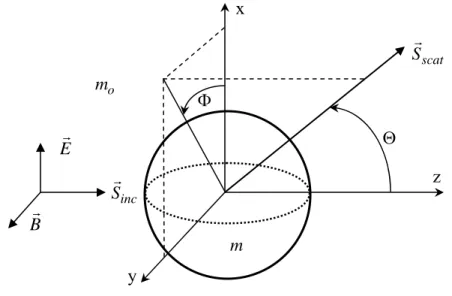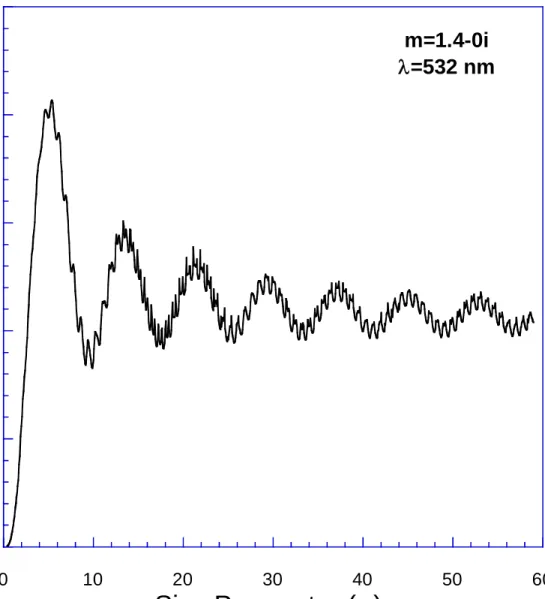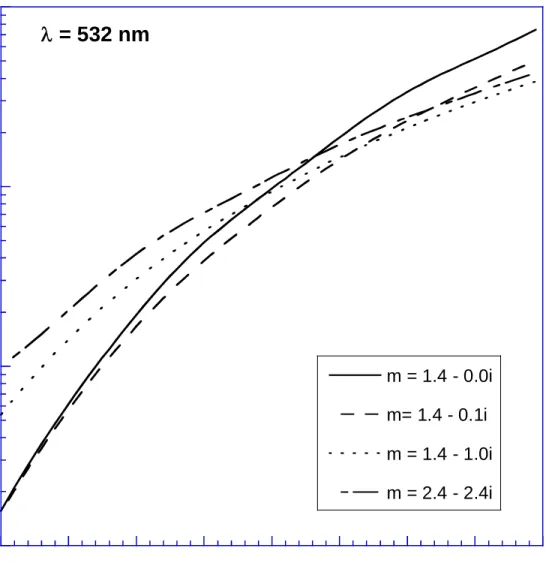Light Scattering Theory
David W. HahnDepartment of Mechanical and Aerospace Engineering University of Florida
(dwhahn@ufl.edu)
Introduction
The scattering of light may be thought of as the redirection of light that takes place when an electromagnetic (EM) wave (i.e. an incident light ray) encounters an obstacle or
non-homogeneity, in our case the scattering particle. As the EM wave interacts with the discrete particle, the electron orbits within the particle’s constituent molecules are perturbed periodically with the same frequency (o) as the electric field of the incident wave. The oscillation or
perturbation of the electron cloud results in a periodic separation of charge within the molecule, which is called an induced dipole moment. The oscillating induced dipole moment is manifest as a source of EM radiation, thereby resulting in scattered light. The majority of light scattered by the particle is emitted at the identical frequency (o) of the incident light, a process referred to as elastic scattering. In summary, the above comments describe the process of light scattering as a complex interaction between the incident EM wave and the molecular/atomic structure of the scattering object; hence light scattering is not simply a matter of incident photons or EM waves “bouncing” off the surface of an encountered object.
Incident EM wave (o) + -+ -Electric field Scattered wave (o)
Formal light scattering theory may be categorized in terms of two theoretical frameworks. One is the theory of Rayleigh scattering (after Lord Rayleigh) that is, strictly speaking as originally formulated, applicable to small, dielectric (non-absorbing), spherical particles. The second is the theory of Mie scattering (after Gustav Mie) that encompasses the general spherical scattering solution (absorbing or non-absorbing) without a particular bound on particle size. Accordingly, Mie scattering theory has no size limitations and converges to the limit of geometric optics for large particles. Mie theory, therefore, may be used for describing most spherical particle scattering systems, including Rayleigh scattering. However, Rayleigh scattering theory is generally preferred if applicable, due to the complexity of the Mie scattering formulation. The criteria for Rayleigh scattering is that <<1 and m<<1, where is the dimensionless size parameter given by the expression
2a
, (1) where a is the spherical particle radius, and is the relative scattering wavelength defined as
o o
m
, (2)
where o is the incident wavelength with respect to vacuum, and mo represents the refractive index of the surrounding medium. Finally, m is the refractive index of the scattering particle, and is commonly represented by the complex notation defined as
m = n - ik. (3)
In this notation, n indicates the refraction of light (i.e. n equals the speed of light in vacuum
divided by the speed of light in the material), while the complex term is related to absorption. The commonly used absorption coefficient of the material (cm-1) is related to the complex part of the refractive index via the relation
4 t coefficien absorption . (4)
It is noted that the value of k is never exactly zero for any material, but materials with a value
approaching zero are termed dielectrics. The magnitude of the refractive index, m , as needed for the Rayleigh criteria, is given by the expression
2 2
1/2
n
m . (5) The Rayleigh criteria as related above, namely <<1 and m<<1, correspond physically to the assumptions that the particle is sufficiently small such that the particle encounters a uniform electric field at any moment, accordingly the time for penetration of the electric field is much less than the period of oscillation of the EM wave.
Figure 1 shows the spherical coordinate scattering geometry used for Mie and Rayleigh light scattering corresponding to a single incident light ray on a single spherical particle. Using this coordinate system, the scattering parameters may be defined for the Rayleigh and Mie solutions.
Figure 2. Coordinate geometry for Rayleigh and Mie scattering. z x y E B inc S scat S o m m
For each scattering angle (,), the Equations (6) and (7) represent the intensities
(W/cm2) of scattered radiation vertically and horizontally polarized with respect to the scattering plane, respectively, which is defined by the incident ray (of intensity Io) and the scattered ray, noting the polarization state of the incident ray as shown in Figure 2,
2 2 1 2 2 sin 4 o I I i r , (6) 2 2 2 2 2 cos 4 o I I i r . (7) For perfectly spherical particles, polarized incident radiation produces similarly polarized scattered radiation; hence the scattering problem may be redefined in terms of the polarization states with respect to the scattering plane. Accordingly, equations (6) and (7) may be recast in terms of the differential scattering cross sections (cm2/sr), namely
' 2 1 VV o VV r I I (8) ' 2 1 HH o HH r I I . (9)
In these two equations, the subscripts refer to the state of polarization of the incident and scattered light, respectively, with orientation defined by the scattering plane. Specifically, the subscripts VV refer to both vertically polarized incident light and vertically polarized scattered
light with respect to the scattering plane (i.e. = 90o). Similarly, the subscripts HH refer to both
horizontally polarized incident light and horizontally polarized scattered light with respect to the scattering plane (i.e. = 0o). For unpolarized incident light, the scattering is given by the
following ' 2 1 scat o scat r I I , (10)
where ' scat is the average of ' VV and ' HH
, and noting there is no dependence on . Finally, it is noted that the dependency of the above quantities on the scattering angle is through the differential cross sections, as detailed below. Equations 8-10 provide an expression for the
intensity of light about a single scattered ray. These equations may also be reconsidered in terms
of the rate of scattered energy into a defined solid angle, as shown in Figure 3.
Figure 3. Angular scattering intensity.
Using the differential scattering cross section, the total scattered energy rate (W) striking dA is
d
I
Escat o scat' , (11)
where the solid angle d is related to the subtended area by d = dA/r2. The units of equation
(11) are readily apparent. Substitution of dA/r2 for the solid angle and division of both sides by dA yields equation (10); hence the scattered intensity about the scattered ray Iscat.
While the above equations account for the redistribution of incident radiation due to light scattering, incident radiation may also be absorbed by the particle. The rate of the total amount
of incident energy abstracted from the incident beam due to interactions with a single particle is calculated directly from the extinction cross section (cm2),
ext o removed I
E . (12)
The extinction cross section represents loss of energy from the incident beam due to both scattering and absorption; hence the extinction cross section may be expressed as
ext = abs + scat, (13)
where abs and scat are the absorption and total scattering cross sections (cm2), respectively. The latter quantity is calculated by integrating the differential cross section over 4 steradians. While the above equations allow calculation of the relevant scattering and extinction quantities based on the incident light intensity, it now falls to the Rayleigh and Mie theories to provide the appropriate expressions for calculation of the various cross-sections expressed above.
Rayleigh Theory
In the Rayleigh regime, the differential scattering cross sections are readily calculated from the following equations:
2 2 2 6 2 2 ' 2 1 4 m m VV , (14) ' ' cos2 VV HH . (15)
Examination of equations (14) and (15) reveals several interesting items. Functionally, the differential scattering cross sections are proportional to the 6th power of particle size, and are inversely proportional to the 4th power of wavelength. This latter dependency gives rise to the blue color of our sky, as the air molecules (e.g. N2 and O2) are well within the Rayleigh regime; hence the shorter blue light of the sun is more efficiently redirected out of the direct path of sunlight and subsequently redirected from all directions as scattered light. In addition, note that the vertical-vertical differential scattering cross section is independent of the observation
angle, while the horizontal-horizontal differential scattering cross section has a minimum at 90o. This implies that unpolarized light will be strongly polarized at 90o observation for
Rayleigh particles. The total scattering cross section (cm2) and absorption cross section (cm2) are defined as 2 2 2 6 2 2 1 3 2 m m sca , (16) 2 1 Im 2 2 3 2 m m abs . (17)
Finally, the total extinction cross section (cm2) is defined as a sum of the scattering and absorption cross sections, namely,
abs sca ext
. (18)
As represented in equations (16) and (17), the scattering cross section scales with 6, while the absorption cross section is proportional to 3. In the Rayleigh regime, the size parameter must be much less than unity, therefore the contribution of scattering (i.e. sca) to the total extinction cross section is generally neglected for an absorbing particle (k 0), and it is therefore assumed that ext abs. However, for a dielectric particle (k 0), then ext scat, as the contribution of absorption is identically zero (abs0).
Mie Theory
Based on the theory of Mie, the differential scattering cross sections are defined in terms of the angular intensity functions i1 and i2, as given by the expressions
2 '
i
2 2 2 ' 4 i HH . (20)
As before, the above two equations are averaged to define the differential scattering cross section for unpolarized incident light, which gives the relation
) ( 8 2 1 2 2 ' i i scat (21)
In this formulation, the intensity functions are calculated from the infinite series given by
2 1 1 2 1 cos cos 1 n n n n n n i a b n n
, (22)
2 2 1 2 1 cos cos 1 n n n n n n i a b n n
. (23)In the equations (22) and (23), the angular dependent functions n and n are expressed in terms of the Legendre polynomials by
cos
(1)
cos
sin n n P , (24)
cos
n(1)
cos
n dP d , (25)where the parameters an and bn are defined as
' ' ' ' n n n n n n n n m m m a m m m , (26)
' ' ' ' n n n n n n n n m m m b m m m . (27)The size parameter is defined using Equations (1) and (2) as
2 o o am . (28)
The Ricatti-Bessel functions and are defined in terms of the half-integer-order Bessel function of the first kind (Jn+1/2(z)), where
1 2 1 2 2 n n z z J z . (29)Equation (30) describes the parameter n
1 2 1 2 2 n n n n z z H z z i z , (30)where Hn+1/2(z) is the half-integer-order Hankel function of the second kind, where the parameter Xn is defined in terms of the half-integer-order Bessel function of the second kind, Yn+1/2(z), namely
1 2 1 2 2 n n z z Y z . (31)Finally, the total extinction and scattering cross sections are expressed as
0 2 Re ) 1 2 ( 2 n n n ext n a b (32)
0 2 2 2 ) ( ) 1 2 ( 2 n n n scat n a b , (33)References
This paper primarily follows the treatment and notation of Kerker (1969) from his classic textbook on light scattering. For those interested in the development of light scattering history, Kerker provides an excellent summary in Section 3.4, Historical Perspective. I consider the following three references to be the classic texts on light scattering:
M. Kerker. The scattering of light and other electromagnetic radiation. Academic, New York,
1969.
H.C. van de Hulst. Light scattering by small particles. John Wiley & Sons, New York, 1957.
(Paperback by Dover Publications, New York, 1981)
C.F. Bohren and D.R. Huffman. Absorption and scattering of light by small particles. John
Wiley & Sons, New York, 1983.
(Paperback by Wily Science Paperback Series, 1998)
Light Scattering Behavior
The following plots briefly depict the behavior of Mie and Rayleigh scattering for
Figure 4. This plot presents the differential scattering cross-section (VV' ) as a function of scattering angle (see Figure 2), hence 0o is forward scattering and 180o is backscattering. The smallest particle size of 17 nm ( = 0.1) is well within the Rayleigh regime, and therefore the angular dependence is negligible. The 170 nm particle ( = 1.0) is departing from the Rayleigh regime, and therefore displays some angular variation, with forward scattering beginning to emerge. Note, however, that the function is still monotonic. The 1.7 m particle ( = 10) is clearly in the Mie regime, where forward scattering dominates. However, note the strong
“ripple” structure as a function of scattering angle. This is characteristic of Mie scattering, and is due to the complex interactions of scattered and refracted rays that result in constructive and destructive interference along different paths (i.e. different scattering angles). Note the scale factors in parentheses for the l7 nm and 1.7 m particle plots, hence these cross-sections vary by more than 10 orders of magnitude for the two-order of magnitude variation in particle size.
10-14 10-13 10-12 10-11 10-10 0 20 40 60 80 100 120 140 160 180
m=1.4-0i
=532 nm
Diff
. Scat
te
ring
Cro
ss Section
(cm
2sr
-1)
Scattering Angle (deg)
(x106) (x10-3)
17 nm
170 nm
1.7
m
Figure 5. This plot presents the extinction efficiency as a function of size parameter. The extinction efficiency is the extinction cross section (ext) normalized by the geometric cross section (a2). For Rayleigh sized particles, the extinction efficiency is much less than 1. For
particles in the Mie regime, two characteristics are noted. The ripple or resonance structure observed in the angular scattering plot is also present with extinction, although not as
pronounced. In addition, the asymptotic limit of the above plot is 2, meaning that in the large particle limit, twice as much energy is removed as expected based on the geometric cross
section. This is contrary to observation, and is referred to as the extinction paradox. In actuality, one half of the energy is removed by scattering/extinction, while the second half is removed via near-forward angle diffraction. Since an observer generally “sees” the diffracted energy, it appears that a large particle only removes energy equal to its actual geometric cross-section.
0 1 2 3 4 5 0 10 20 30 40 50 60
m=1.4-0i
=532 nm
Q
ex tSize Parameter (
)
Figure 6. This plot presents the differential scattering cross section at a fixed angle of 15o for vertical-vertical scattering ( '
VV
) as a function of scattering particle diameter for various particle refractive indices. Data are presented for a dielectric, as well as increasingly absorptive
particles, and finally for a particle with enhanced refraction and absorption. The main point illustrated from these plots is the complex nature of the dependency of Mie scattering on
refractive index. It is very difficult to make a priori assumptions about the relative magnitude of
scattering for a given particle size and scattering angle with regard to the value of refractive index m. 10-11 10-10 10-9 10-8 200 250 300 350 400 450 500 550 600




